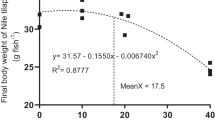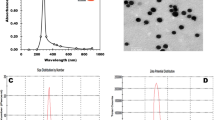Abstract
Nickel (Ni) has not been elucidated as an essential mineral in dairy animals, though in plants and lower organisms, its role in activation of urease enzyme is well known. This study was conducted to evaluate the effect of Ni supplementation on intake, growth performance, urease activity, antioxidant and immune status, and energy and lipid metabolism in growing cattle. Eighteen growing Hariana heifers were randomly allocated into three groups on body weight (125 ± 3.0 kg) and age basis (10 ± 2.0 months). Feeding regimen was similar in all the groups except that treatment groups were supplemented with 0.0 (Ni0.0), 1.5 (Ni1.5), and 3.0 (Ni3.0) mg of Ni/kg dry matter (DM) in three respective groups. DM intake (DMI), average daily gain (ADG), feed efficiency, plasma urease activity, biomarkers of antioxidant and immune status, energy and lipid metabolism, and plasma Ni levels were observed during the 90-day experimental period. There was linear increase (p < 0.05) in mean DMI and ADG without affecting feed efficiency was observed in 3.0 mg of Ni/kg DM supplemented heifers. Dietary Ni supplementation showed linear increase (p < 0.05) in mean plasma urease activity. No effects of (p > 0.05) of Ni supplementation were observed on superoxide dismutase (SOD) and catalase (CAT) activity and plasma lipid peroxide (LPO) concentration; whereas, mean plasma total antioxidant status (TAS) showed linear decrease (p < 0.001) in Ni-supplemented groups. Adding Ni up to 3.0 mg of Ni/kg DM did not exert (p > 0.05) any effect on plasma total immunoglobulin and immunoglobulin G (IgG) concentrations. Mean plasma cortisol level showed negative association with supplemental Ni levels and concentration was found lowest (p < 0.05) in 3.0 mg of Ni/kg DM-added group. Dietary Ni supplementation did not affect mean plasma concentrations of glucose, cholesterol, triglyceride, and non-esterified fatty acids (NEFA). There was a linear increase (p < 0.001) in plasma Ni concentrations as the Ni concentrations increased in the diet. The results of present study indicated that dietary supplementation of 3.0 mg of Ni/kg DM improved performance of growing cattle by increasing urease activity.



Similar content being viewed by others
References
Garg MR, Bhanderi BM, Biradar SA, Kukreja JL, Sherasia PL (2007) Dietary mineral status of lactating buffaloes in Kolhapur district of Maharashtra State in India. Ital J Anim Sci 6(supplement 2):484–487
Nielsen FH (1980a) Evidence of the essentiality of arsenic, nickel and vanadium and their possible nutritional significance. In: Draper HH (ed) Advances in nutritional research, 3rd edn. Plenum Press, New York, pp 157–172
Davies BE (1981) Trace element pollution. In: Davis BE (ed) Applied soil trace elements, 4th edn. John Wiley and Sons, Chichester, pp 287–351
Nielsen FH (2000) Importance of making dietary recommendations for elements designated as nutritionally beneficial, pharmacologically beneficial, or conditionally essential. J Trace Elem Exp Med 13:113–129
Afridi HI, Kazi TG, Kazi N (2011) Evaluation of status of cadmium, lead, and nickel levels in biological samples of normal and night blindness children of age groups 3–7 and 8–12 years. Biol Trace Elem Res 142(3):350–361
La Bella FS, Dular R, Lemons P, Vivian S, Queen M (1973a) Prolactin secretion is specifically inhibited by nickel. Nature 245:330–332
Jason S (2014) Insight into the structure and mechanism of nickel-containing superoxide dismutase derived from peptide-based mimics. Acc Chem Res 47:2332–2341
Cabassi E (2007) The immune system and exposure to xenobiotics in animals. Vet Res Commun 31:115–120
Alverez C, Blade C, Catana J (1993) Alpha-2 adrenergic blockage prevents hyperglycemia and hepatic glutathione depletion in nickel-injected rats. Toxicol Appl Pharmacol 121(1):112–117
Kojima M, Masui T, Nemoto K, Degawa M (2004) Lead nitrate induced development of hypercholesterolemia in rats: sterol independent gene regulation of hepatic enzymes responsible for cholesterol homeostasis. Toxicol Lett 154:35–44
McDonald IW (1948) The absorption of ammonia from the rumen of sheep. J Biochem 42:584–587
Somers M (1961) Factors influencing the secretion of nitrogen in sheep saliva. The influence of injected urea on the quantitative recovery of urea in the parotid saliva and the urinary excretions of sheep. Austral J Exp Biol Med Sci 39:145–156
Spears JW, Smith CJ, Hatfield EE (1977) Rumen bacterial urease requirement for nickel. J Dairy Sci 60:1073–1076
Nielsen FH, Myron DR, Givand SH, Zimmerman TJ, Ollerich DA (1975b) Nickel deficiency in rats. J Nutr 105:1620–1630
Schnegg A, Kirchgessner M (1978) Ni deficiency and its effects on metabolism. In: Kirchgessner M (ed) Trace element metabolism in man and animals. University of Munich, Freising-Weihenstephan, West Germany, pp 236–243
Anke M, Henning A, Grun M, Partschefeld M, Groppel B, Ludkf H (1977) Nickel, an essential trace element. The supply of nickel as affecting the live weight gains, food consumption and body composition of growing pigs and goats. Arch Fur Tier 27:25–34
Anke M, Kronemann H, Groppel B, Hennig A, Meissner D, Schneider HJ (1980b) The influence of nickel deficiency on growth, reproduction, longevity and different biochemical parameters of goats. In: Proceeding of 3rd International Trace Element Symposium. University Leipzig-Jena, Jena, pp 3–10
Spears JW, Hatfield EE (1980) Role of nickel in ruminant nutrition. In: Anke M, Schneider HJ, Bruckner C (eds) Spurenelement-symposium, nickel. Friedrich-Schiller University, Jena, pp 47–53
NRC (2001) Nutrient requirements of dairy cattle, 2nd revised edn. National Research Council, National Academy of Sciences, Washington, DC
AOAC (2005) Official methods of analysis, 18th edn. Association of Official Analytical Chemists, Arlington
Van Soest PJ, Robertson JB, Lewis BA (1991) Symposium: carbohydrate methodology, metabolism and nutritional implications in dairy cattle. Methods for dietary fiber, neutral detergent fiber and non starch polysaccharides in relation to animal nutrition. J Dairy Sci 74(10):3583–3597
Talapatra SK, Roy SC, Sen KC (1940) The analysis of mineral constituents in biological materials. Estimation of phosphorus, chlorine, calcium, manganese, sodium and potassium in foodstuffs. Ind J Vet Sci Anim Husb 10:243–258
Madesh M, Balasubramanian KA (1998) Microtiter plate assay for superoxide dismutase using MTT reduction by superoxide. Ind J Biochem Biophys 35(3):184–188
Aebi H (1984) Catalase in vitro. Methods Enzymol 105:121–126
Benzie IFF, Strain JJ (1999) Ferric reducing/antioxidant power assay: direct measure of total antioxidant activity of biological fluids and modified version for simultaneous measurement of total antioxidant power and ascorbic acid concentration. Methods Enzymol 299:15–27
Rehman SU (1984) Lead induced regional lipid peroxidation in brain. Toxicol Lett 21:333–337
Mc Ewan AD, Fisher EW, Salman IE, Penhale WJ (1970) A turbidity test for the estimation of immune globulin levels in neonatal calf serum. Clin Chem Acta 27:155–163
AOCS (2011a) Urease actvity, official methods and recommended practices of the American Oil Chemist Society, 6th edn. Second Printing, Urbana
O’Dell GD, Miller WJ, King WA, Moore SL, Blackman DM (1970) Nickel toxicity in the young bovine. J Nutr 100:1447–1454
O’Dell GD, Miller WJ, Moore SL, King WA, Ellers JC, Jurecek H (1971) Effect of dietary nickel level on excretion and nickel content of tissues in male calves. J Anim Sci 32:769–773
Kirchgessner M, Roth FX (1977) For the injection of Ni allowances on the growth of piglets. J Anim Physiol Anim Nutr 39:277–281
Spears JW, Hatfield EE, Forbes RM (1979) Nickel for ruminants II, influence of dietary nickel on performance and metabolic parameters. J Anim Sci 48:649–657
Spears JW (1984) Nickel as a ‘newer trace element’ in the nutrition of domestic animals. J Anim Sci 59:823–834
Oscar TP, Spears JW, Shih JC (1987) Performance, methanogenesis and nitrogen metabolism of finishing steers fed monensin and nickel. J Anim Sci 64(3):887–896
Houpt TR (1959) Utilization of blood urea in ruminants. Am J Physiol 197:115–120
Spears JW, Harvey RW, Samsell L (1986) Effects of dietary nickel and protein on growth, nitrogen metabolism and tissue concentrations of nickel, iron, zinc, manganese and copper in calves. J Nutr 116:1873–1882
Milne J, Whitelaw F, Price J, Shand W (1990) The effect of supplementary nickel on urea metabolism in sheep given a low protein diet. Anim Sci 50(3):507–512
Oscar TP, Spears JW (1988) Nickel-induced alterations of in vitro and in vivo ruminal fermentation. J Anim Sci 66(9):2313–2324
Deka RS, Mani V, Kumar M, Zade SS, Kaur H (2015) Chromium supplements in the feed for lactating Murrah buffaloes (Bubalus bubalis): influence on nutrient utilization, lactation performance, and metabolic responses. Biol Trace Elem Res 168(2):362–371
Singh S, Kumar M, Kumar V, Roy D, Kushwaha R, Vaswani S, Singh Y, Singh SK (2016) Evaluation of molasses based biomethanated distillery spent wash as an alternative feed for growing cattle. Indian J Anim Nutr 33(4):388–393
Kumar M, Kaur H, Mani V, Deka RS, Tyagi AK, Chandra G, Dang AK, Kushwaha R (2017) Supplemental chromium in cold-stressed buffalo calves (Bubalus bubalis): effects on growth performance, nutrient utilization and cell mediated and humoral immune response. Vet Arhiv 87(4):441–456
Das KK, Das SN, Dasgupta S (2001) The influence of ascorbic acid on nickel induced hepatic lipid peroxidation in rats. J Basic Clin Physiol Pharmacol 12:187–194
Gupta AD, Patil AM, Ambekar JG, Das SN, Dhundasi SA, Das KK (2006) L-ascorbic acid protects the antioxidant defense system in nickel-exposed albino rat lung tissues. J Basic Clin Physiol Pharmacol 17:87–100
M’Bemba-Meka P, Lemieux N, Chakrabarti SK (2005) Role of oxidative stress, mitochondrial membrane potential, and calcium homeostasis in nickel sulphate-induced human lymphocyte death in vitro. Chem Biol Interact 156:69–80
Liapi C, Zarros A, Theocharis S, Voumvourakis K, Tsakiris S (2011) Short-term exposure to nickel alters the adult rat brain antioxidant status and the activities of crucial membrane-bound enzymes: neuroprotection by L-cysteine. Biol Trace Elem Res 143(3):1673–1681
Smialowicz RJ, Rogers RR, Riddle MM, Geraldine AS (1984) Immunologic effects of nickel: I. suppression of cellular and humoral immunity. Environ Res 33(2):413–427
Graham JA, Miller FJ, Daniels MJ, Payne EA, Gardner DE (1978) Influence of cadmium, nickel, and chromium on primary immunity in mice. Environ Res 16(1–3):77–87
Schiffer RB, Sunderman FW Jr, Baggs RB, Moynihan JA (1991) The effects of exposure to dietary nickel and zinc upon humoral and cellular immunity in SJL mice. J Neuroimmunol 34:229–239
Stejskal V, Hudecek R, Stejskal J, Sterzl I (2006) Diagnosis and treatment of metal-induced side-effects. Neuroendocrinol Lett 27(Suppl. 1):7–16
Lorenson MY, Robson DL, Jacobs LS (1983) Divalent cation inhibition of hormone release from isolated adenohypophysial secretory granules. J Biol Chem 258:8618–8622
Cartana J, Arola L (1992) Nickel-induced hyperglycaemia: the role of insulin and glucagon. Toxicol 71(1–2):181–192
Obone E, Chakrabarty SK, Bai C, Malick MA, Lamantagne L, Subramanian KS (1999) Toxicity and biaoaccumulation of nickel sulphate in Sprague-Dawley rats following 13 weeks of subchronic exposure. J Toxicol Environ Health 57:379–401
Horak E, Zygowicz ER, Tarabishy R, Mitchell JM, Sunderman FW Jr (1978) Effects of nickel chloride and nickel carbonyl upon glucose metabolism in rats. Ann Clin Lab Sci 8(6):476–482
Kantola T, Kivisto KT, Neuvonen PJ (1998) Grapefruit juice greatly increases serum concentration of lovastatin and lovastatin acid. Clin Pharmacol Ther 63:397–402
Acknowledgments
The authors would like to thank the staff of the Department of Animal Nutrition and Instructional Livestock Farm Complex, DUVASU, Mathura, India. The authors also gratefully acknowledge Dr. Atul Prakash, Dr. Arvind Tripathi, and Dr. Yajuvendra Singh for assistance during research work.
Funding
The fund for this study was provided by University under Indian Council of Agricultural Research Grant, New Delhi, India.
Author information
Authors and Affiliations
Corresponding author
Ethics declarations
Animal care procedures were approved (approval number, 115/IAEC/17) and conducted under the established standard of the Institutional Animal Ethics Committee (IAEC), constituted as per article number 13 of the Committee for the Purpose of Control and Supervision of Experiments on Animals (CPCSEA) rules laid down by the Government of India.
Conflict of Interest
The authors declare that they have no conflict of interest.
Rights and permissions
About this article
Cite this article
Singh, A., Kumar, M., Kumar, V. et al. Effects of Nickel Supplementation on Antioxidant Status, Immune Characteristics, and Energy and Lipid Metabolism in Growing Cattle. Biol Trace Elem Res 190, 65–75 (2019). https://doi.org/10.1007/s12011-018-1524-6
Received:
Accepted:
Published:
Issue Date:
DOI: https://doi.org/10.1007/s12011-018-1524-6




